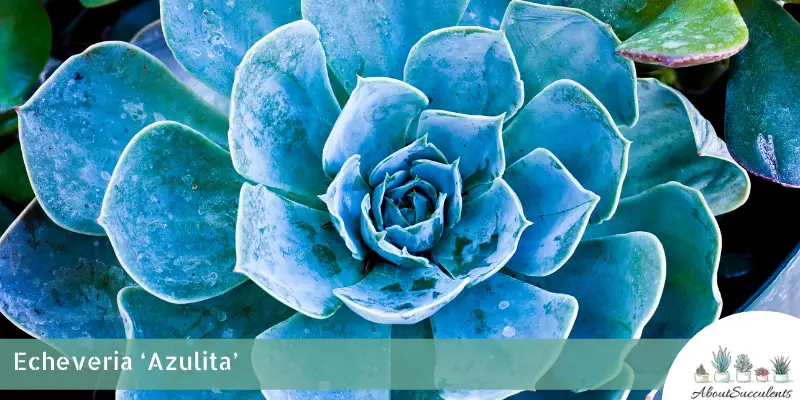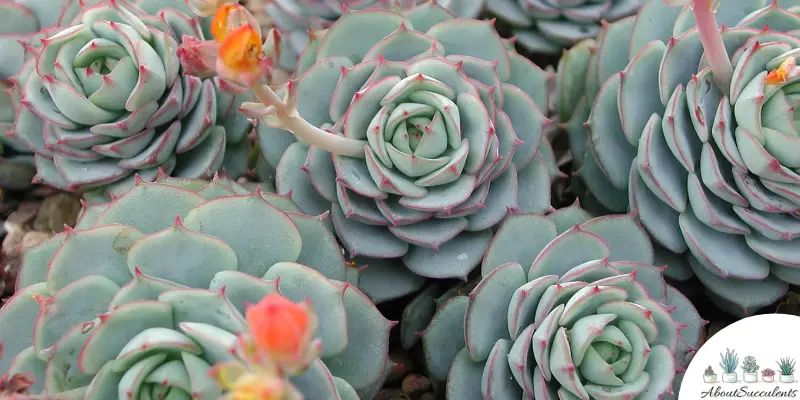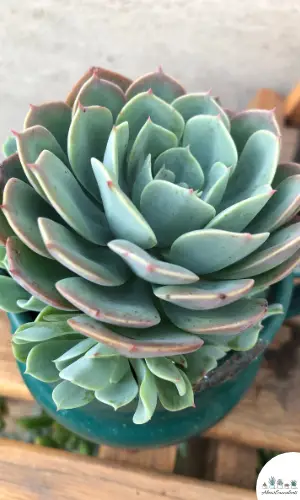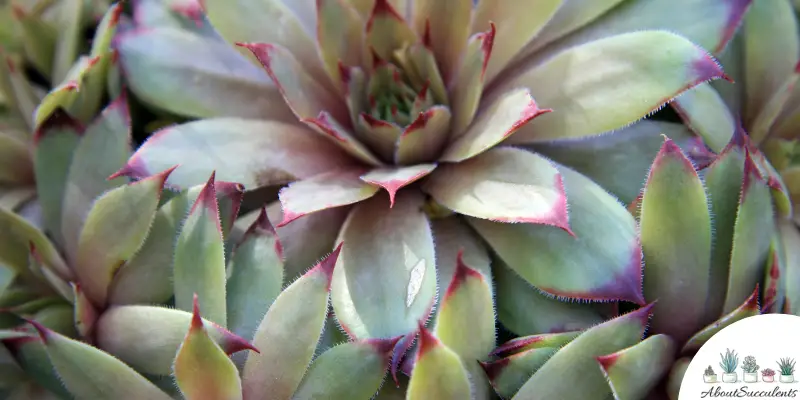
Echeveria “Azulita” enchanting beauty is made possible by its thick, blue-green colored leaves that have a velvety feel and a waxy texture about them. In some species of Azulita, the leaves appear to be covered with tiny hairs. When exposed to direct sunlight the tips of the leaves turn pink.
The fleshy leaves of Azulita or “Little Blue One” grow several, tiny, blue-green rosettes that form into a tight but symmetrical spiral. There are some variations of Azulita with leaves that vary in color from blue-green to gray to lavender.
In the springtime, Echeveria Azulita produces flowers that vary in color from bright orange to pink. When the succulent blooms these lovely flowers, expect your garden to be visited regularly by hummingbirds and butterflies.
Azulita can reach a height of 5-inches (12.7cm) and a width of 6-inches (15cm). It is a hybrid of Echeveria minima that was created by Renee O’Connell and introduced by Altman Plants. Echeveria Azulita is native to Mexico and is a member of the Crassulaceae family.
General Information
Also known as: Azulita
Plant Family: Crassulaceae
Origin: Mexico
Height: 5-inches (12.7cm)
Exposure: Partial to full sun for up to 5 hours per day.
Water Needs: Drought-tolerant; Azulita does better with fewer waterings. Follow the “Soak and Dry” method.
Soil Type: Well-draining succulent soil or a mixture of potting soil plus 50% gritty materials such as perlite, coarse sand, and pumice for improved drainage.
Soil pH: 5.6 to 7.8
How to Grow and Care for Echeveria “Azulita”

You’ll be excused for thinking that Echeveria Azulita must be hard to take care of given its striking beauty and allure. Don’t let Little Blue One’s looks fool you. Azulita might look high maintenance, but she’s not.
Echeveria Azulita can be grown outdoors in a rock garden or as an accent piece on your backyard patio. Azulita is also grown indoors because according to horticulturists the magnificent succulent has air purifying capabilities.
It would be best to grow Azulita in a movable container if the temperature in your region drops below 20° F (-6.7° C) because this type of succulent isn’t cold-hardy. Once the weather turns frosty, bring Azulita indoors right away.
Sunlight
As an addition to your outdoor succulent garden, plant Echeveria Axulita in an area that gets 6 hours of partial or full sun every day. The one thing to remember about giving your succulent sunlight is to avoid exposing it to the afternoon sun because the intense rays will burn Azulita’s much-desired leaves.
Lighting remains an important consideration when growing Azulita indoors. Position Azulita near a window that receives 4 to 6 hours of partial sunlight daily. If you’re not certain of the level of exposure, buy a Grow Light for Azulita. Place the succulent under the Grow Light for up to 6 hours per day.
If the succulent doesn’t get the required amount of sunlight, it will undergo a process called etiolation where the leaves stretch out as if they were searching for the sun. When the plant etiolates, the leaves wither and die.
Watering

Succulents are drought-tolerant because they have the ability to store water in their leaves and stems. Echeveria Azulita is able to survive the harsh conditions in Mexico because it can go long periods without water.
In fact, succulents prefer to have less water. If its soil is watered while there’s still moisture, it becomes a breeding ground for fungi and other types of bacteria. Likewise, the roots become susceptible to rotting.
If the roots rupture and rot, it gives the fungi access to your succulent. Once inside the plant, an infection can spread and Azulita can die.
For this reason, only water the soil when it’s 100% dry. Use the “Soak and Dry” method when watering Azulita.
Check the soil’s dryness by inserting a stick. If the stick feels dry after you pull it out, the soil is ready to receive water – lots of water. During the summertime, you might water Azulita every seven to 10 days. In the winter, the soil stays moist longer. You might only need to water the soil once a month.
Another important rule to follow is to water only the soil. Don’t water above or the plant directly.
Pot and Soil
Now that you know how important it is to dry out the soil, drainage should remain the top priority when choosing the ideal pot and soil type for Echeveria Azulita.
Most nurseries package succulents in plastic containers. Once you buy your succulent, replant it in a pot that’s made of terracotta or unglazed ceramic because these materials allow moisture to leave the soil right away.
The pot should be slightly bigger than the base of Azulita to support aeration and to keep the roots from getting entangled as the plant grows. Lastly, make sure the pot has a large enough drain hole at the bottom.
Succulent soil or potting soil with 50% added gritty materials like perlite, coarse sand, pumice, or lava rock are good choices for Azulita.
How to Propagate Echeveria “Azulita”

Thinking of what to give your family and friends for Christmas or on their birthdays? Avoid the shopping rush and just propagate more Azulitas in your own home.
There are 2 methods you can use to propagate Echeveria Azulita: Leaves and Offsets.
Leaves Method
Step 1: Perform a clean twist and pull on a healthy leaf. If a part of the leaf remains on the stem, repeat the process. You can’t have successful propagation if the leaf is removed incorrectly.
Step 2: Allow the leaves to develop calluses. You can do this by placing them in a dry area for up to 4 days.
Step 3: Place the callused leaves on top of well-draining soil. Make sure they are evenly spaced out.
Step 4: Water the soil lightly and place the pot near a window that gets 4 to 6 hours of partial sunlight every day.
Step 5: If the roots have formed, switch to the “Soak and Dry” method for watering succulent plants.
Offsets Method
Step 1: Free up the offsets by cutting away with a sharpened and sterilized knife or gardening shears.
Step 2: Gently uproot the offsets.
Step 3: Let the offsets callus over for 2 to 4 days.
Step 4: Plant the offsets in well-draining soil.
Step 5: Moisten the soil by spraying it with water. Move the pot near a window that assures the offsets 4 to 6 hours of daily sunlight.
Step 6: Once the roots have taken hold, only provide water when the soil has completely dried out.
Frequently Asked Questions
Is Echeveria “Azulita” Toxic to Cats and Dogs?
Echeveria Azulita doesn’t appear in the list of plants that are toxic to cats and dogs found on the website of the American Society for the Prevention of Cruelty to Animals (ASPCA).
Why Is My Echeveria “Azulita” Dying?
Echeverias are known to be durable varieties of succulents. They can handle harsh growing conditions and require very little care and attention. However, they can die from overwatering and pest infestation.
Both factors can lead to infection and compromise the health of Azulita. You can nurse the succulent back to health by following our tips below.
Overwatering
When the fungi find their way inside your plant, they will spread rapidly through the leaves and stems. You know the fungal infection is taking place if the leaves look mushy and you notice discoloration.
To keep the fungi from spreading, remove all of the infected sections with a sharp knife. Remember to sterilize the knife or gardening shears with 70% isopropyl alcohol before and after cutting.
Once all of the infected sections have been removed, turn your attention to the roots. Remove Azulita from the pot and cut off all of the roots that have rotted away.
Next, allow Azulita to recover in a clean and dry area while you begin preparing a new pot by filling it up with fresh succulent soil. Replant Echeveria in the new pot but give it 2-3 days before watering the soil.
Pest Infestation
Echeveria Azulita’s leaves contain sap that mealybugs and scale insects are attracted to. These pests will not only drain Echeveria of valuable sap but also leave behind white, waxy substances that can contaminate your succulents.
Wipe away the substances with a cotton ball soaked with 70% isopropyl alcohol. Spray Echeveria Azulita with diluted neem oil to keep pests away.
Yes, Echeveria Azulita produces flowers in the springtime. These beautiful flowers vary in color from bright orange to pink and attracts hummingbirds and butterflies.
Last Updated on June 9, 2022 by Sofia Lara